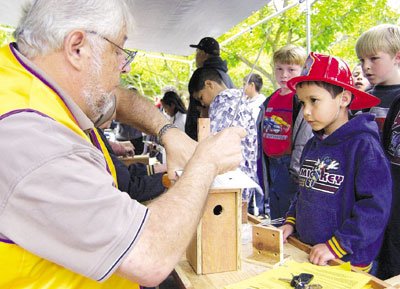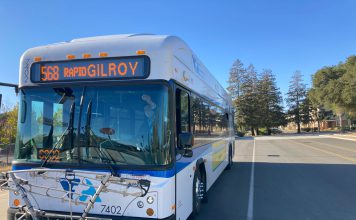When you think of service clubs such as the Elks, Lions, Rotary,
Masons, Kiwanis, Moose and Grange, you probably have visions of
older people making up the bulk of the membership.
By Julie Englehardt Special to South Valley Newspapers
When you think of service clubs such as the Elks, Lions, Rotary, Masons, Kiwanis, Moose and Grange, you probably have visions of older people making up the bulk of the membership. Many of the clubs have members who are 60 or older and joined after retirement as a way to become involved in their communities. But as these members age and numbers dwindle because of illness or death, what do the clubs do to attract new members?
That question is always on the mind of Wayne Weller, Exhalted Ruler of the Gilroy Elks Lodge. Weller became a member 10 years ago after retiring from a 35-year stint with the United States Navy. He was interested in joining the Elks because he saw it as a way to meet people in Gilroy.
The Elks work with area Veterans Administration hospitals, something that held great appeal for Weller. Locally, the Elks donate money to Live Oak and Gilroy High schools, and the club recently donated $4,000 to the Gateway Center for the Handicapped, and $2,000 to the Fisher House Foundation, which provides housing for the families of loved ones going through rehabilitation at VA hospitals.
The Gilroy Elks lodge seems to be doing well membership-wise, even though Weller said numbers have dropped from 612 to 594 during the past few months.
“When I joined 10 years, ago, we had about 925 members,” Weller said. “The issue that we’re faced with is that we’re losing members through death because of the age (factor). Or, many people are moving out of the state. There are many factors which are contributing to our numbers falling.”
They do have a membership committee whose sole purpose is to recruit newer members, and Weller said they’d love to have people who are under 50 join the lodge.
“But when you’re younger you’re busy with work and family obligations,” Weller said. “One way we’re trying to entice younger members to join is by letting them know about the youth organizations we work with. I’ve also started to realize that we need to stay in contact with our new members so they feel as if they belong. Many feel that if they don’t hear from some of the long-time members that we’ve forgotten about them, so we try to keep that in mind.”
Yet, there are young people like Andrew Trinchero, 21, who joined the Lodge just a few months ago. His 92-year-old grandfather has been a Lodge member for the past 66 years. Although Trinchero is busy with his classes at Gavilan College and work commitments, he wanted to be an Elk so he could become involved in community events.
“The main reason why I joined the Elks was because of all of the civic/charity work they do,” he said. “The Elks help raise money for many children’s charities and scholarship funds. I would strongly encourage anyone interested to get an application. There’s a great sense of pride that comes with being an Elk – a sense of belonging to an organization that helps people in need all over the U.S.A. Being a member of the Elks has helped me better understand myself, and the community I live in.”
Hollister is also home to many service organizations, one of them being the Rotary Club. The Rotary Club was founded in 1905 and the Hollister chapter formed in 1925. Rotary is primarily an organization of business and professional people who provide humanitarian service.
The Hollister chapter donates $20,000 worth of scholarships to San Benito High School, San Andreas High School and the Pinnacles Community/Court School annually. It also supports Community Pantry, Boy Scouts and Girl Scouts, YMCA of San Benito County, United Way, youth leadership programs, Emmaus House and the Bulldog Youth Boxing Club.
Hollister Rotary has about 100 members, and according to club secretary Bryan Yamaoka, this number has remained constant for the past few years. When he joined in 1997, it had about 110 members, but dipped into the mid-90s a few years back. Members tend to be in their 50s, 60s and older, but Yamaoka said they have one member, Roy Schmidt, who will turn 94 this summer.
Yamaoka said that there are some younger members in their 30s and 40s, but commented that Rotary seeks out people who are the owner of the company or in senior management, so they may be somewhat older.
“We have bank managers, CPA’s, people in real estate, and financial investors,” he said. “But, we’re open to younger members as well. They may actually be someone who has been appointed, by their boss or manager, to be a company representative at our meetings.”
“We’re always looking for new members,” Yamaoka added. “We do lose members through illness or death, but many times it has to do with business pressures and not having the time to commit to the club.”
Lions Club International is another organization that has a long-standing tradition of providing service locally, nationally and internationally. Its main goal is to service the blind and visually impaired by recycling eyeglasses, partnering with sight-related organizations, and donating money for the SightFirst Program, which was launched to battle preventable blindness.
The Morgan Hill chapter formed in 1938, and besides being involved with sight-related activities, members work with local youth, donating money and providing support for agricultural-related activities at the schools, plus they support Community Solutions, a comprehensive human services agency that serves South Santa Clara County and surrounding areas. They also provide scholarships for students at Live Oak High School.
Although the Lions do noble work, keeping membership up is always a challenge, said Lon Davis, secretary of the Morgan Hill chapter. Their club has only 20 members.
“All the clubs I know have trouble with membership, basically out here, because we live in a bedroom community,” Davis said. “People are commuting in the morning and they’re commuting at night and they’re taking their kids to baseball, swimming and soccer. Nobody wants to make the time. It isn’t on the top of anybody’s priority list and nobody wants to do it until they’re sitting around, retired and have nothing better to do. Then they get involved with something like that.”
Davis said that most of their advertising for new members is done by word of mouth, or they hand out flyers at the Mushroom Mardi Gras or at other community events, but finding members is still tough.
“You have to be committed and willing to put the time in your schedule,” Davis said. “You need to want to make a difference, because what’s going to come out in the end – helping somebody else.”













